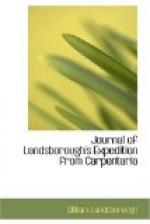At 6.10, three-quarters of a mile south-east to a point above junction of a dry watercourse where we made our Number 4 camp. The edges of the plain which we saw today in following up the river are of the richest soil, and only sufficiently timbered to afford firewood for a pastoral population. The grasses are of the best description. This is the character of the whole of the country we have seen since we left our first camp. There is no appearance on the country we have crossed of its having had rain for a long time; but from the strong stream of water in the river I think there must have been plenty of rain on the country higher up. I saw today, on several low places, saltbush which the horses ate, of a kind I have often seen in the western country from Rockhampton, but never before so near to the coast. By following the river it has taken us nearly right on our course towards Mount Stuart.
Wednesday November 20. Camp Number 4.
Situated on right bank of the Gregory River. Started at 8.13 a.m. and steered south for about three miles, until 9.25; then I had to change our course to south-south-east for about half a mile to where we tried to cross the river, but could not find a suitable place for doing so. Started again at 10.15 and reached at 11.15, by a south course, two and a quarter miles to where we crossed a dry creek near its junction with the river. We continued steering on the same course south for about one mile, when we reached the bank of the river, and a further continuation of the same course for one mile brought us to a place on the river where we watered the horses. The watering-place was boggy but we could find no better. Started again at 2.4 p.m., and at 3.30 made one and a half miles south-south and by east; at 4 made one and a half miles in a south-east direction, to where I went in search of a crossing-place, and in doing so followed the river in a south-east direction for two and a half miles without finding a place where the horses could approach even near enough to the river to get a drink without a risk of their falling into the deep water. We followed up the Gregory River thirteen miles by the courses I have mentioned. We found the branding-irons did not answer for branding trees, as it took a much longer time to do so than to mark them with a tomahawk, so we buried them at a tree marked Dig, at the camp we left this morning. Last night we had a potful of the young wood of the cabbage palm, which tasted like asparagus. All the country we have seen today is of a similar character to that described in yesterday’s journal. This afternoon we reached country on which rain had fallen recently and it was in consequence covered with herbage so green that we did not think the horses on it would require water during the night, so their not having been able to approach it earlier in the day was not of any consequence. We encamped but the night was so short and the mosquitoes so troublesome that, what with watching and getting up at 3.45, we had hardly sufficient sleep. I found at this time that the duties of exploring gave very little time for fishing or shooting. At this period of our journey the sextant was too much out of order for making sufficiently accurate observations of the stars.




